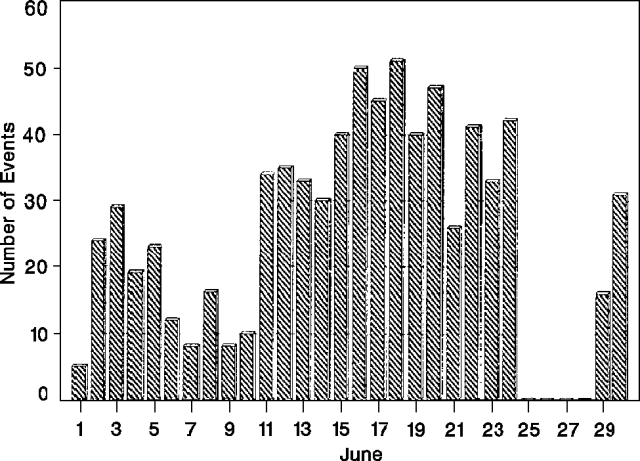Report on Arenal (Costa Rica) — June 1992
Bulletin of the Global Volcanism Network, vol. 17, no. 6 (June 1992)
Managing Editor: Lindsay McClelland.
Arenal (Costa Rica) Lava production and tephra ejection continue
Please cite this report as:
Global Volcanism Program, 1992. Report on Arenal (Costa Rica) (McClelland, L., ed.). Bulletin of the Global Volcanism Network, 17:6. Smithsonian Institution. https://doi.org/10.5479/si.GVP.BGVN199206-345033
Arenal
Costa Rica
10.463°N, 84.703°W; summit elev. 1670 m
All times are local (unless otherwise noted)
Lava production, tephra ejection, and fumarolic activity continued through mid-July. Most of the W-flank lava moved down a channel feeding the flow's S lobe, which moved into young forest on the WSW flank, an area that had been affected by the 1968 pyroclastic flows. Since mid-May, the S lobe's front had advanced almost 300 m, reaching 665 m elevation on 10 June and 650 m elevation by the 24th. As it advanced, the lava flow continued to start fires that burned well over a hectare of the surrounding woodland. Between 12 and 22 July, the flow front advanced at an average rate of ~20 m/day, reaching ~2.5 km from the new summit crater (C). The lava supply to the N lobe had dwindled, and its front had halted at 830 m elevation.
Explosions were stronger and more numerous in June than in May. Some caused rumbling that vibrated house windows in La Palma, 4 km N of the volcano. An impact crater 1 m in diameter and 30 cm deep was found at 780 m elevation on the W flank, and large blocks frequently reached slightly >1 km from the new summit crater (C) 12-22 July. Some ash columns rose >1 km above Crater C. The rate of explosions varied; during observations on 12 June, an explosion was heard every hour. Ashfall on the observation point at 780 m elevation, 1.8 km W of the active crater, accumulated more rapidly in the 4 weeks ending 10 June than in the succeeding 2 weeks (see table 5). Vegetation on the NE, E, and SE flanks continues to be affected by acid rain and tephra fall, as it has for more than 20 years. Fumarolic activity occurred from the remnants of the old summit crater (D).
Volcanic seismicity recorded at a station (Fortuna) 4 km E of the active crater averaged 30 events/day, with a maximum of 51 on 18 June (figure 48). Conspicuous tremor episodes occurred on 4, 6, 10, 17, and 30 June. The level of both seismic and pyroclastic activity decreased 12-22 July, as did the number of avalanches from the advancing lava flow front.
 |
Figure 48. Daily number of seismic events recorded at a station (Fortuna) 4 km E of Arenal's active crater, June 1992. Courtesy of the Instituto Costarricense de Electricidad. |
Geological Summary. Conical Volcán Arenal is the youngest stratovolcano in Costa Rica and one of its most active. The 1670-m-high andesitic volcano towers above the eastern shores of Lake Arenal, which has been enlarged by a hydroelectric project. Arenal lies along a volcanic chain that has migrated to the NW from the late-Pleistocene Los Perdidos lava domes through the Pleistocene-to-Holocene Chato volcano, which contains a 500-m-wide, lake-filled summit crater. The earliest known eruptions of Arenal took place about 7000 years ago, and it was active concurrently with Cerro Chato until the activity of Chato ended about 3500 years ago. Growth of Arenal has been characterized by periodic major explosive eruptions at several-hundred-year intervals and periods of lava effusion that armor the cone. An eruptive period that began with a major explosive eruption in 1968 ended in December 2010; continuous explosive activity accompanied by slow lava effusion and the occasional emission of pyroclastic flows characterized the eruption from vents at the summit and on the upper western flank.
Information Contacts: E. Fernández, J. Barquero, and V. Barboza, OVSICORI; G. Soto, ICE; M. Fernández, Univ de Costa Rica.

